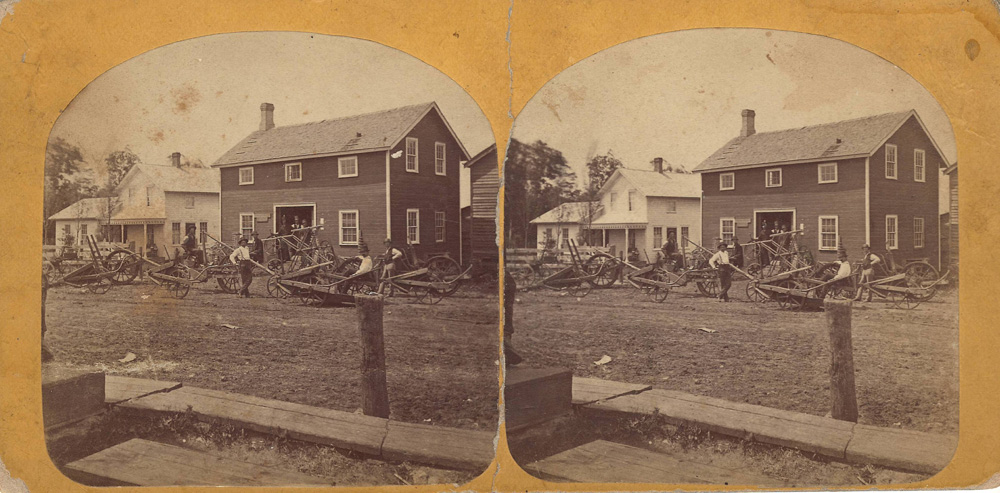Made in America with Foreign Parts
10 Norwegian Wafer (Krumkake) Iron
Norwegian Wafer (Krumkake) Iron
Norwegian-American
Torgrim Fjeld/Field, c.1870
Metal (iron)
Museum acquisition
MHAHS 1991.044.0001
For many Norwegian-Americans, krumkake represents the sweet flavor of Christmas served with their favorite hot drink, coffee. After the batter is cooked in the krumkake iron, the delicately stamped cookie is rolled into the shape of a cone while still warm. Once cooled, the crisp cookie is filled with whipped cream or fruit.
Torgrim Fjeld, a Norwegian immigrant and Mount Horeb blacksmith, designed this iron. It features an ornate relief image of a sheaf of wheat encircled by the biblical prayer, “Give us this day our daily bread,” written in Norwegian. The text may reveal Fjeld’s religious response to the prominent wheat farming industry in his new home.

As the holiday season begins, many of us share warm and delightful memories of time spent with family and friends. So much of that time spent together is enriched with personal, regional, or cultural traditions. Few traditions remain as timeless as the recipes passed down from generation to generation, seasoning memories of celebration. For many Norwegian-Americans, krumkake is reminiscent of the sweet flavor of Christmas served aside their favorite hot drink, coffee. [1] This light, crisp cookie is made by setting a dollop of batter onto the iron, closing the iron, and cooking it over a stovetop or fire. Once it is cooked, the wafer is rolled into a cone and filled with whipped cream or fruit. These delicate, holiday-favored wafers annually reiterate a family’s Norwegian cultural heritage to generation long past and new ones yet to come.[2]
When Norwegian immigrants first arrived in America, they were surprised by the regions’ culinary preferences and by differences in what ingredients were available. For instance, certain Norwegian-Americans were taken aback by the preeminence of pork in the American diet and had to adapt recipes to their new home’s preferred meat source while learning to stomach a richer diet. On the other hand, they were delighted by the surplus of sugar used as a primary ingredient in traditional pastries such as the krumkake.[3]
Though referenced as an easy recipe, krumkake requires a specific cast iron mold to cook the thin wafer over an open fire. Some Norwegian-American immigrants valued their heavy krumkake irons enough to take them on the journey from Norway to America, but for those who didn’t transport the iron in their already limited luggage space, skilled immigrants like Torgrim Fjeld could make an authentic iron for them in their new hometown.[4]
Torgrim Fjeld was a Norwegian immigrant and blacksmith who owned a wagon repair shop in Mt Horeb in the nineteenth century. Born in Valdres, Norway in 1849, he moved to America in 1860 with his father Reverend John Fjeld, his mother Gunhild Torgrimsdatter Hesjebakken Fjeld and three siblings.[5] Though Fjeld primarily repaired wagons, he discovered that krumkake irons were in such high demand that he needed help delivering and selling them to neighboring communities. Marten Venden, the grandfather of Mt Horeb resident Olianna Cuneen who was locally well-known for her Norwegian arts and crafts such as rosemalling, drove a wagon to nearby towns to sell Fjeld’s krumkake irons, stamped with TJ Fjeld should anyone admire his work.
Fjeld designed this iron with an ornate relief representing his Norwegian-American identity. The iron impresses the traditional cookie with the image of a sheaf of wheat encircled by the biblical prayer, “give us this day our daily bread,” written in Norwegian.[6] The biblical text referencing wheat and bread hint at Fjeld’s personal background. As the son of a minister, he would likely be familiar with the biblical quote, but he designed the plate with something truly local to the American Midwest: a wheat sheaf. Perhaps, we can imagine the design binding together Fjeld’s religious upbringing with his new home and its prominent wheat farming industry. In turn, the plates might indicate his new community identity, Wisconsin farmers recalling their memories of home through the food they share.
References
[1] National Museum of American History, Smithsonian. Accessed March 25, 2017. http://americanhistory.si.edu/collections/search/object/nmah_1321759
[2] For more on food and ethnic identity, see Donna R. Gabaccia, We Are What We Eat: Ethnic Food and the Making of Americans, (Cambridge and London: Harvard University Press, 1998).
[3] Richard J. Fapso, Norwegians in Wisconsin, (Madison, Wisconsin: The Wisconsin Historical Society Press, 2001) 27.
[4] Wisconsin Historical Society “Ethnic Holiday” Accessed March 25, 2017. http://www.wisconsinhistory.org/museum/exhibits/p2p/green/ethnic_holiday.asp
[5] “Wafer Iron.” Wisconsin Decorative Arts Database. Accessed March 23, 2017. http://content.wisconsinhistory.org/cdm/ref/collection/wda/id/283
[6] “Giv Os I Dag Vort Daglige Brod”


